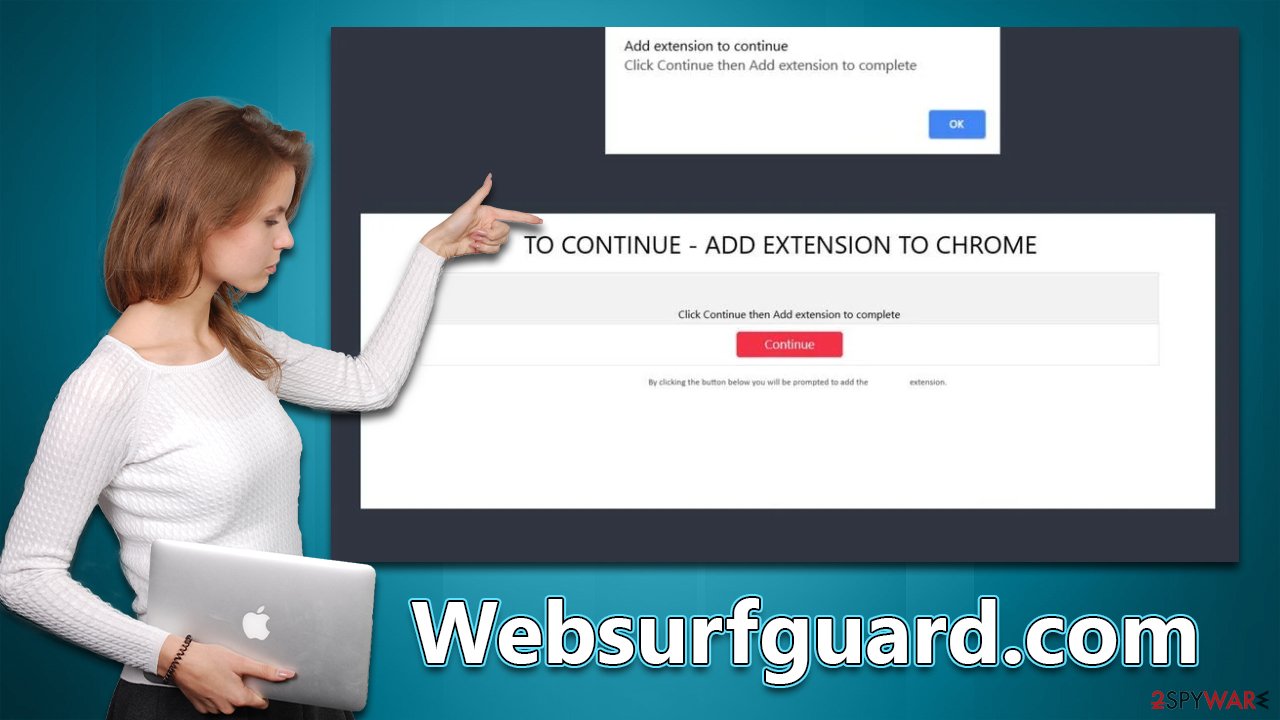Websurfguard.com ads (fake) - Free Instructions
Websurfguard.com ads Removal Guide
What is Websurfguard.com ads?
Websurfguard.com is a dubious website created to make users download potentially unwanted software

Users typically don't encounter Websurfguard.com ads unless they're redirected to the site by accident. This usually happens when people visit high-risk websites, such as those that distribute illegal programs or software cracks. In rarer cases, increased advertisement activity and constant redirects while browsing the web might indicate an infection of adware or another potentially unwanted program.
As soon as users enter the Websurfguard.com site, they are usually exposed to a variety of scam schemes and phishing messages that would encourage them to download potentially unwanted applications or redirect them to other dubious websites. As a result, people may install malicious software, disclose their personal details to cybercriminals or waste money on useless services or goods online.
In case Websurfguard.com redirects are repeated, or you notice that you keep encountering phishing material online while browsing, along with an increased number of ads, there is a high chance that your system is infected with adware or other potentially unwanted software. We provide the guide to its elimination below.
| Name | Websurfguard.com |
| Type | Redirect, scam, phishing, adware |
| Distribution | Software bundles, malicious websites |
| Symptoms | Shows fake ads and promotes potentially unwanted applications |
| Risks | Installation of potentially unwanted software, such as browser hijackers. Redirects may also lead to dangerous sites, resulting in financial loss or personal data exposure to unknown parties |
| Removal | You should not interact with the content shown by the fake site. Instead, check your system for adware or other malware with SpyHunter 5Combo Cleaner security software |
| Other tips | Remove caches and other web data to prevent data tracking – use the FortectIntego repair and maintenance tool. You can also repair damaged system components with it |
Example of scamming techniques used
Everyone who uses the internet will eventually come across some form of online fraud. Whether it's a phishing message or something else, these scams always benefit the person behind them financially by tricking an unsuspecting victim. Websurfguard.com's goal is to generate revenue by manipulating users who are not as tech-savvy and convincing them to download software that has no value.
There are plenty of techniques that could be used to reach this goal, and the more users are exposed to the scam, the better it is for the crooks behind it. These methods are used on numerous other websites to make people do what they otherwise wouldn't, including subscribing to push notifications on Datingstyle.top, or making people purchase security software by showing them fake virus infection alerts, as seen on Piran.live.
On Watchadsfree.com, you might be told that some extension installed on your browser is out of date and needs to be updated immediately “to continue.” Likewise, you may be simply presented with a prompt such as:
Download Ready
Click Download and Install Recommended Chrome Extensions
Never download any plugins or programs unless you are absolutely sure of their safe origins, as some might contain malware that could infect your device with ransomware.[1] If you believe you may have installed an unwanted app, please follow the removal guide and other security tips below.

Remove adware and other unwanted software
Although adware infections (mostly) don't pose a serious threat to your computer, they can be annoying. Pop-ups and other advertisements may appear while you're browsing the web if your computer is infected with adware. To get rid of these ads, it's important to remove the infection properly.
We recommend you begin by scanning your system with SpyHunter 5Combo Cleaner or [3], both of which are reliable anti-malware programs. By doing this, all malware will be instantly deleted from your system. In addition, any files and processes related to the virus will also be removed immediately.
Some browser extensions might not be detected by security tools because they come from legitimate sources such as Chrome Web Store. However, it is a well-known fact that some malicious extensions bypass Google's safety scanners and enter the store, resulting in thousands or even millions of users downloading the app before it's removed.[2] To remove potentially unwanted extensions, follow these steps:
Google Chrome
- Open Google Chrome, click on the Menu (three vertical dots at the top-right corner) and select More tools > Extensions.
- In the newly opened window, you will see all the installed extensions. Uninstall all the suspicious plugins that might be related to the unwanted program by clicking Remove.
![Remove extensions from Chrome Remove extensions from Chrome]()
Mozilla Firefox
- Open Mozilla Firefox browser and click on the Menu (three horizontal lines at the window's top-right).
- Select Add-ons.
- In here, select the unwanted plugin and click Remove.
![Remove extensions from Firefox Remove extensions from Firefox]()
MS Edge (Chromium)
- Open Edge and click select Settings > Extensions.
- Delete unwanted extensions by clicking Remove.
![Remove extensions from Chromium Edge Remove extensions from Chromium Edge]()
Safari
- Click Safari > Preferences…
- In the new window, pick Extensions.
- Select the unwanted extension and select Uninstall.
![Remove extensions from Safari Remove extensions from Safari]()
Some potentially unwanted programs may be installed on the system level, but if they are aggressive enough to cause browser redirects and show pop-up ads, most security programs will remove them at once. If this step seems confusing to you, don't worry about it. Otherwise, start with Windows:
- Enter Control Panel into the Windows search box and hit Enter or click on the search result.
- Under Programs, select Uninstall a program.
![Uninstall from Windows 1 Uninstall from Windows 1]()
- From the list, find the entry of the suspicious program.
- Right-click on the application and select Uninstall.
- If User Account Control shows up, click Yes.
- Wait till the uninstallation process is complete and click OK.
![Uninstall from Windows 2 Uninstall from Windows 2]()
With Macs, application removal might seem straightforward, as most of them can be uninstalled by moving them to Trash. However, adware might insert additional files, settings, and other components in order to increase persistence. Therefore, we recommend performing additional steps on a Mac:
- From the menu bar, select Go > Applications.
- In the Applications folder, look for all related entries.
- Click on the app and drag it to Trash (or right-click and pick Move to Trash)
![Uninstall from Mac 1 Uninstall from Mac 1]()
To fully remove an unwanted app, you need to access Application Support, LaunchAgents, and LaunchDaemons folders and delete relevant files:
- Select Go > Go to Folder.
- Enter /Library/Application Support and click Go or press Enter.
- In the Application Support folder, look for any dubious entries and then delete them.
- Now enter /Library/LaunchAgents and /Library/LaunchDaemons folders the same way and terminate all the related .plist files.
Once all potentially unwanted apps are deleted, it is time to take care of your browsers. When PUPs or malware are installed on the system, they often drop cookies[3] or other items to track various information about users, including their web browsing activity, technical data, and more.
To stop this tracking, we recommend you delete web data from your browsers. This practice is recommended to perform periodically to avoid cache errors and data trackers that accumulate over time. The easiest way of doing this is by using FortectIntego PC repair and maintenance utility, although a manual option is also available:
Google Chrome
- Click on Menu and pick Settings.
- Under Privacy and security, select Clear browsing data.
- Select Browsing history, Cookies and other site data, as well as Cached images and files.
- Click Clear data.
![Clear cache and web data from Chrome Clear cache and web data from Chrome]()
Mozilla Firefox
- Click Menu and pick Options.
- Go to Privacy & Security section.
- Scroll down to locate Cookies and Site Data.
- Click on Clear Data…
- Select Cookies and Site Data, as well as Cached Web Content and press Clear.
![Clear cookies and site data from Firefox Clear cookies and site data from Firefox]()
MS Edge (Chromium)
- Click on Menu and go to Settings.
- Select Privacy and services.
- Under Clear browsing data, pick Choose what to clear.
- Under Time range, pick All time.
- Select Clear now.
![Clear browser data from Chroum Edge Clear browser data from Chroum Edge]()
Safari
- Click Safari > Clear History…
- From the drop-down menu under Clear, pick all history.
- Confirm with Clear History.
![Clear cookies and website data from Safari Clear cookies and website data from Safari]()
How to prevent from getting adware
Stream videos without limitations, no matter where you are
There are multiple parties that could find out almost anything about you by checking your online activity. While this is highly unlikely, advertisers and tech companies are constantly tracking you online. The first step to privacy should be a secure browser that focuses on tracker reduction to a minimum.
Even if you employ a secure browser, you will not be able to access websites that are restricted due to local government laws or other reasons. In other words, you may not be able to stream Disney+ or US-based Netflix in some countries. To bypass these restrictions, you can employ a powerful Private Internet Access VPN, which provides dedicated servers for torrenting and streaming, not slowing you down in the process.
Data backups are important – recover your lost files
Ransomware is one of the biggest threats to personal data. Once it is executed on a machine, it launches a sophisticated encryption algorithm that locks all your files, although it does not destroy them. The most common misconception is that anti-malware software can return files to their previous states. This is not true, however, and data remains locked after the malicious payload is deleted.
While regular data backups are the only secure method to recover your files after a ransomware attack, tools such as Data Recovery Pro can also be effective and restore at least some of your lost data.
- ^ Ransomware. Imperva. Application and data protection.
- ^ Google removes apps for secretly copying phone numbers. BBC. News.
- ^ Cookies and Web Beacons. NTT. NTT Communications.











